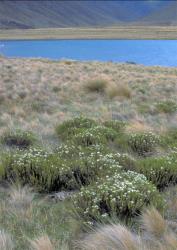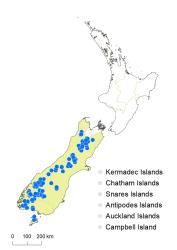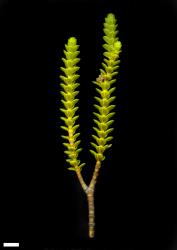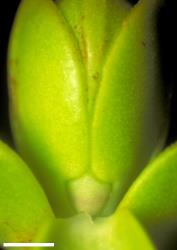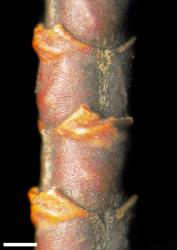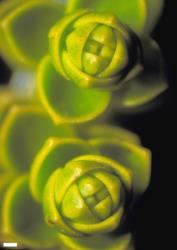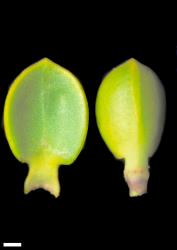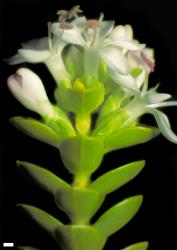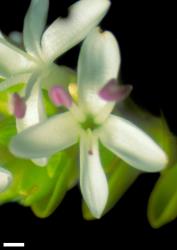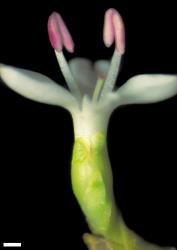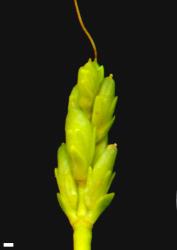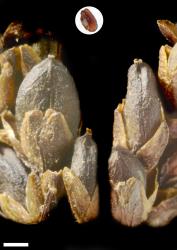- ≡ Hebe buxifolia var. pauciramosa Cockayne & Allan, Trans. & Proc. New Zealand Inst. 56: 27 (1926)
- ≡ Hebe pauciramosa (Cockayne & Allan) L.B.Moore in Allan, Fl. New Zealand 1, 925 (1961)
- ≡ Leonohebe pauciramosa (Cockayne & Allan) Heads, Bot. Soc. Otago Newsl. 5: 10 (1987)
Compact or straggling shrub to 0.5 m or rarely to 1.0 m tall. Stems ascending to stiffly erect, sparingly branched, eglandular-pubescent, hairs bifarious. Leaf bud distinct, its leaves appressed until fully grown; sinus broad, shield-shaped. Leaves opposite-decussate, erecto-patent, rarely sub-erect or spreading; lamina coriaceous, rigid, broadly oblong or elliptic to sub-orbicular, 3–9 mm long, 2.2–8.0 mm wide, glossy dark green above and beneath; midrib evident and characteristically flattened in a patch just short of the apex; surfaces glabrous; margin glabrous or minutely ciliolate, entire; apex obtuse to bluntly apiculate; base truncate to cordate; petiole 0.5–3.0 mm long. Inflorescence a lateral spike, 7–20 mm long; flowers crowded, 2–12, all bisexual; bracts elliptic to deltoid, > pedicels but not overtopping calyx; pedicels erect, 0–0.5 mm long, glabrous or with a few scattered eglandular hairs. Calyx lobes 4, the anterior pair fused ⅔-way to apex or more, obtuse, 3–4 mm long, sub-equal, minutely eglandular-ciliolate. Corolla 10–14 mm diameter; tube white, 3.7–5.0 mm long, > calyx, glabrous or eglandular-hairy inside; lobes 4, white, spreading to recurved, sub-equal, narrowly elliptic to elliptic, 5.0–6.5 mm long, obtuse, rounded, or sometimes the posterior lobe emarginate; nectar guides absent. Stamen filaments white, 3.7–5.5 mm long; anthers magenta. Style glabrous, 3.8–8.0 mm long. Capsules latiseptate, obtuse, glabrous, 4.0–5.5 mm long, 2.5–3.5 mm at widest point. Seeds ellipsoid or broadly ellipsoid, flattened, smooth, pale brown, 1.1–1.8 mm long.
odora | mooreae | pauciramosa | masoniae | venustula | brachysiphon | |
|---|---|---|---|---|---|---|
Leaf bud sinus | broad, shield-shaped | narrow & acute to broad & shield shaped | broad, shield-shaped | broad, shield-shaped | narrow, acute | narrow, acute |
Leaf margin | sharply bevelled; glabrous | bevelled at 90º to surfaces, glabrous | rounded; glabrous or with minute hairs or denticles | rounded, papillate towards apex; ciliolate when young | weakly bevelled; ciliolate when young, becoming glabrous or papillate | weakly bevelled; ciliolate to ciliate when young, becoming papillate |
Stomata | adaxial – (but often + at Arthur’s Pass); abaxial + | adaxial – (+ at Caswell Sound, Denniston); abaxial + | adaxial +; abaxial + | adaxial +; abaxial + | adaxial ±; abaxial + | adaxial ±; abaxial + |
Midrib | sharply keeled beneath | depressed above; prominent beneath | rounded beneath and flattened just short of apex | keeled throughout | evident but not keeled | evident but not keeled |
Inflorescence | terminal + usually lateral spikes | lateral spikes only | lateral spikes only | terminal spikes only | lateral raceme, sometimes ternate, rarely compound. | lateral raceme, sometimes ternate. |
Bracts | not overtopping calyx | < calyx | < calyx | ≥ calyx | ≥ pedicels, < calyx | ≥ pedicels, < calyx |
Bracts and flowers | opposite | opposite | opposite | opposite | opposite below, becoming alternate | alternate, or lowermost opposite |
Pedicels | 0 mm | 0–1 mm | 0–0.5 mm | 0 mm | 0.5–7.0 mm | 0.6–3.0 mm |
Calyx, anterior lobes | free | free or fused to ⅓-way | fused > ⅔-way | free | free | free |
Corolla lobes | narrow | broad | narrow | broad | ± broad | ± broad |
South Island: Western Nelson, Marlborough, Westland, Canterbury, Otago, Fiordland, Southland.
Stewart I. (Mt Anglem / Hananui, Mt Rakeahua).
Bogs, seepages, and moist sites in sub-alpine to alpine tussock grassland. Recorded elevations range from 609 to 1718 m.
Flowers: November–January (sometimes to March); fruits: January–May (sometimes persisting to November).
2n = 42 (see Bayly & Kellow 2006, as Hebe pauciramosa).
Veronica pauciramosa is classified in V. subg. Pseudoveronica sect. Hebe and the informal group “Buxifoliatae” (Albach & Meudt 2010; Bayly & Kellow 2006). V. pauciramosa consistently emerges as sister species to V. odora in nuclear ITS trees (e.g., Wagstaff et al. 2002). This sister species pair is sister to a cluster of V. epacridea and V. kellowiae (Wagstaff et al. 2002), and also V. haastii and V. macrocalyx (E.M. Low, unpublished), which all have similar inflorescences.



